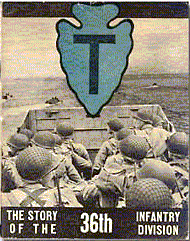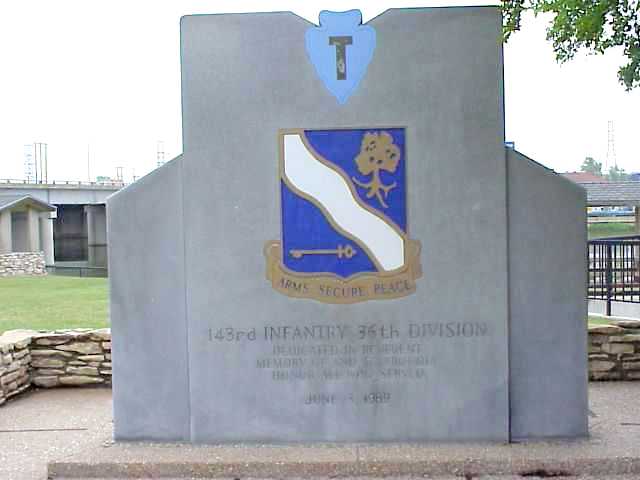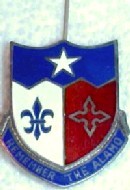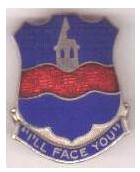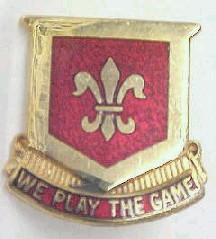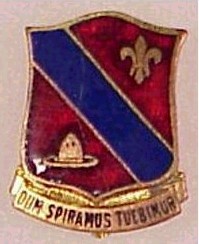|
Dec. 13, 1944: The 36th Infantry Division, fighting desperately
in the
Colmar Pocket, was cut off. A fierce, fanatical enemy had smashed
back the point of the Texas Division’s lines, sliced hard through the
flanks,
cut rear communications.
First Bn., 142nd Regt., holding the left bank in Selestat, withstood
vicious
assaults of two Russia-hardened enemy divisions, sent them reeling back
and heavy casualties. Five hundred Germans struck at the
center
of the line, infiltrated back as far as the 141st Regt.’s CP in
Riquewihr.
Cook, clerks, other rear echelon troops had to be called to help drive
them out.
An enemy assault battalion of officer candidates slashed in from the
south,
cut the supply lines of the 3rd Bn., 143rd Regt. Meanwhile, German
engineers
slipped through to artillery positions, blew up a howitzer, mined and
blocked
a road to the rear. The ring around the T-Patchers was sealed.
Swiftly and efficiently the 36th fought back. At the division CP in
Ribeauville,
every available man guarded road blocks. Anti-tank obstacles were
hastily
manned. MP and engineer patrols lashed out to clear the road. The
143rd,
cutting across a ridge to the rear of the infiltrating Germans, smashed
strong reserves coming up for the kill.
The 36th held, slowly pushed back the stubborn Kraut thrusts, finally
broke
the steel trap. On Dec, 19, its lines straightened, the 36th resumed
its
traditional role as attacker.
The Germans hated and feared the 36th. They had met it before in the
Vosges
and the Riviera, at Cassino and Salerno, on the Marne in 1918. They had
never been able to crush it; they never would. A proud division, the
36th
boasted a history dating back to 1835 and the Alamo, to 1899 and the
Rough
Riders, to World War I.
Originally composed of Texas National Guardsmen, the 36th was mobilized
into the Army of the United States Nov. 25, 1940, at Camp Bowie, Tex.,
in the fiercest ice storm in Texas history.
In the next three years, with replacements from every state, the
division
maneuvered in the Carolinas and Louisiana, “invaded” Martha’s Vineyard,
trained at Massachusetts’ Camp Blanding. It reached fighting trim in
Africa,
at Arzew and Rabat.
ROAD
TO ROME VIA SALERNO, CASSINO
Sept. 9, 1943; In the pre-dawn blackness, T-Patchers tumbled off the
ropes
into small landing craft bobbing on Salerno Bay. They were eager and
ready
for their first combat mission. The threat of invasion had forced
Italy’s
surrender, and the announcement, made just nine hours before the
jump-off,
had spread rapidly throughout the ships. Some men thought the invasion
would be cancelled but the operation went ahead. Confident, tough,
doughs
hit the deck:
“It’ll
be a cinch,”
the sergeant said. “Won’t last a month.” He bunched his
pack higher on his shoulders and counted off his squad."
Salerno was a fierce baptism of fire for the 36th. The small landing
boats
bucked the surf, grounded on the beach. Men charged ashore, cut paths
through
mine fields and barbed wire. An enemy outpost marked them with machine
gun tracers. Krauts were waiting - waiting with 88s on the ridges, with
tanks on the flats.
The landing barely had been accomplished when the Germans launched
their
first armored attack. On the right flank, Nazis barreled through to the
beaches, where 3rd Bn., 141st, in a bloody man-to-tank action, threw
them
back. For this action, the battalion received the first Presidential
Citation
awarded a 36th unit.
On the left flank, two more armored spearheads slashed at the
lines.
One assault nearly reached the division CP. A hastily-unlimbered 105,
firing
point-blank into the formation, destroyed five of 13 tanks. The others
fled. A self-propelled 75 and a 37 stood off a second attack. Bazooka
teams
held the flanks. The original landings had withstood every counter-blow
the enemy could muster. {"75" - 75
mm
cannon. "37" - 37mm cannon. The 37mm gun was assigned to
the
Heavy Weapons company of an infantry division.}
Altavilla
was taken, the forces in it trapped and scattered. But the Germans
regrouped
and punched their way back into the town. When an attack to retake the
town by seizing vital Hill 424 failed, the division pulled back its
defense
along the rim of the landing area.
Every man who could be spared from field ranges, typewriters and trucks
was in the line Sept. 13. Striking hard far to the left, the Germans
had
breached the Sele-Calore corridor. U.S. paratroop units were dropped
along
the defense perimeter, rushed into position before the enemy could
exploit
his tactical advantage.
Guts, firepowr and teamwork decided the battle of Salerno that day.
T-Patchers
sealed off the Nazis along little La Cosa creek and drove off the
lumbering
panzers. Covered by naval and land guns, doughs rolled the enemy back
into
the hills. Altavilla was retaken.
Four 36th Div. men won the Congressional Medal of Honor at
Salerno.
T/Sgt. Charles E. “Commando” Kelly, Pittsburgh, held
off
the Germans alone by throwing mortar shells when there were no more
grenades.
On Hill 424, Pvt. William Crawford, Pueblo, Colo., grenaded
several
machine gun nests, captured another machine gun position and fought the
enemy until he was captured. Lt. Arnold Bjorklund, Seattle,
Wash.,
grabbed an enemy rifle, destroyed two German machine guns with it.
T/Sgt. James
Logan, Luling, Tex., single-handed wiped out machine gun nests
which
held up an entire battalion, advanced alone to rout snipers which
covered
his unit’s positions.
The 36th pulled back to establish defensive positions and detached 3rd
Bn., 143rd; Btry. A, 155th FA,
and the 133rd FA
to join Rangers in a sea-borne end-run that seized Naples and drove the
Germans several miles beyond, freeing the main Fifth Army supply port.
With large numbers of reinforcements, the 36th went back into the lines
Nov. 15, in the lower Liri Valley just north of Venafro, to begin one
of
the most grueling and vicious campaigns in the history of modern
warefare.
Wrote Maj. Gen. Fred L. Walker, Division CG at the close of the
campaign:
While
subject to
hardships that have never before been exceeded by any
troops anywhere, you drove the enemy from well-organized and
stoutly-defended
positions in the hill masses of Camino and Sammucro, from Maggiore,
Mount
Rotundo, and San Pietro. You punished him severely.
Hardships: knee-deep and wheel-deep mud, foxhole-engulfing mud;
insufficient
winter equipment; rain and snow, cold and sleet. Howitzer trails that
couldn’t
be dug in. One round fired and the guns buried themselves. Trucks that
bogged down in soupy ground. Machine gun barrels that froze. Shoes that
wore out in one day on sharp rocks jutting up through the snow.
To understand that winter’s campaign, picture a wine bottle. The cork
was
a Cassino, and the lower Liri Valley was the long neck reaching up to
the
stopper. The 36th had to advance along the sides of the neck — the
mountains
and craggy masses.
Mount Maggiore came first. It was named “Million Dollar Mountain” after
the pulverizing barrage which devastated its slopes.
In a masterly-coordinated night attack, the 142nd grabbed strategic Mount
Longo.
Massed artillery was turned on San Pietro, key to the German
mountain-crest
line. The first infantry assaults had been beaten back; tanks trying to
bull their way up the narrow roads had been annihilated. San Pietro was
nearly blown off the earth; it seemed that no German could survive the
bombardment. Yet, Germans lived under the stunning blows, hid in the
rubble,
stood off the infantry that followed on the heels of the barrarage.
Only
after doughs had come downfrom Longo and Hill 1205 on the flanks were
the
Nazis finally eliminated.
The Italian village of San Pietro — population 1400 — had been
liberated.
There was one American casualty for every freed Italian. {Actual
name of this town was San Pietro Infinite. There were
many
towns and mountains with similar names. The story of this battle was
recorded
in a 30-minute documentary made by John Houston for the Army, entitled
"The Battle of San Pietro".}
The Rapido River, skirting Cassino, was the retaining band on the cork.
Fifth Army elected to crack it by a frontal assault in an S-bend
opposite
Cassino. If ever the Germans were prepared to meet an attack, it was
then
and there. The 141st on the right and the 143rd on the left drove
gallantly
into the strongest defenses of the line, were thrown reeling back.
Squads
reformed from companies led by sergeants and launched another violent
attack.
Enemy mines were too thick; observation too good; machine guns firing
almost
from the rear, from the flanks and chopping down Yank assault elements.
Attack after attack was ripped apart by the wicked cross-fire.
S/Sgt. Thomas McCall, Viedersburgh, Ind., led one attempted
crossing
of the Rapido. The young squad leader got across, formed his small
group
to make a determined stand in an untenable position. Although taken
prisoner,
he later was awarded the Congressional Medal of Honor.
The 36th remained in the line for a month after the futile smashes into
the Rapido River positions. The men dug into the cold, barren slopes of
Mount Cairo, behind Cassino, and Castellone Ridge which fringed it.
The freezing winter seemed an eternity. Doughs advanced a yard one day,
five yards another, paying in blood for every gain. Mule trains were
the
sole source of supply in those hills, and where the mules wouldn’t go,
frightened by the incessant nebelwerfer and artillery fire, the men had
to carry rations, ammunition and wire, and packboard it through the
mine
fields themselves.
He was six feet four ; he carried four blankets, two bulging medical
pouches
and
anything else he could sling on his back. He carried one end of a
litter
himself, and
wore out three relays at the other end. Sgt. Joe Vedvarka, “The
Terrible
Czech,”
evacuated a wounded man off Cairo in three hours one night. It took the
mule trains eight.
One by one, division units trickled off the lines for rest and
retraining
in late February through April.
Brig. Gen. Walter W. Hess’ Div Arty went into action in early May on
the
Garigliano River, and on May 25, the entire Texas Division, reformed on
the Anzio beachhead, kicked off on the northward drive to break the
stalemate.
The sustained drive carried all the way to Velletri, key bastion in the
German line defending Rome, another cork in another bottle. The 36th
pulled
the cork.
Both the 141st and the 143rd hurled themselves directly against
Velletri.
During the night, the 142nd took to the densely-wooded hills on the
flank
and infiltrated behind the town. Not a shot was fired as the 142nd
crept
around and over the top of Mount Artemisio, to trap the German
garrison.
The 143rd pulled out to follow it. In hard, close in-fighting, the
141st
took Velletri.
Eric
Sevareid, commentator for the Columbia Broadcasting System,
wrote: “This action... turned the key to the city of Rome and handed it
to Gen. Mark Clark.”
The 36th entered Rome.
The division followed this major success by rampaging 240 miles up the
Italian peninsula, slamming aside German defenders at Magliano and
Grossetto
in short, sharp, decisive battles. Through the heavy Italian dust,
tank-riding
doughs pressed forward, artillery close behind. The Germans threw out
rear
guards, mostly short, puzzled Mongolians.
Magliano was different; first-rate enemy troops were encountered.
S/Sgt. Homer
Wise, Baton Rouge, La., earned the division’s sixth Congressional
Medal of Honor at Magliano, smashing a strong enemy position with
tommy
gun, rifle, grenades, and BAR, leaping on a tank to clear a jammed
machine
gun and rake the Germans from his exposed position.
When the 36th finally came off the lines near Piombino, June 29, after
spearheading the entire Fifth Army, Associated Press’
Ken
Dixon, wrote: “It seemed right and just that the 36th would be the men
to chalk up these achievements.”
The division withdrew to Paestum, and on the same beaches that had
witnessed
their battle baptism, the troops paraded in farewell to Gen. Walker.
Maj.
Gen. John E. Dahlquist took command as the 36th prepared for its second
invasion.
Eleven months of Italian warfare had changed the Texas Division. The
ranks
of National Guardsmen slowly had thinned. Of 11,000 casualties, 2000
were
Texans; at Salerno alone: 1900 casualties, 750 from Texas.
But the 36th had made the Germans pay heavily, too — 6000 prisoners in
addition to enormous numbers killed and wounded.
T-PATCH
BLITZ OPENS RHONE VALLEY
“I know what you want,” said the mayor of Draguinan. He led the
colonel to a beautiful, walled garden, quiet and shaded. “You want a
cemetery. All the people of my town have contributed to give you this
land. It is the gift of the people of Draguinan to their
liberators.”
Aug. 15, 1944, 0800 hours: First Bn., 141st, scrambled ashore on Blue
Beach.
Unlike Salerno, the way had been paved by overwhelming naval and aerial
bombardment. As a covering rocket basrrage lifted, 2nd and 3rd Bns.
landed
on Green Beach, near the tiny village of Dramont.
For rooting the Germans from the slopes overlooking the beaches, 1st
Bn.,
141st was a awarded a Presidential Citation.
|
Omitted
Portion of Text not related to Campaign in Italy
|
For the fighting in the Colmar Pocket, both 1st Bn., 142nd, in
Selestat,
and 2nd Bn., 141st, which held the far right flank of the line, were
awarded Presidential
Citations.
Gen. De Monsabert of the French II Corps, under which the 36th fought,
paid this tribute to the division:
It was for me the signal honor of my career to have under my orders
such
companions in arms. I shall never forget it.
For this campaign, three additional T-Patchers received the Congressional
Medal of Honor: Pfc Gerald S. Gordon, St. Joseph, Mo., a
medic
who tore off his arm band to help stem the advancing enemy near
Ribeauville;
Sgt. Ellis Weicht, Everett, Pa., who was killed at St.
Hippolyte
while cleaning out enemy machine gun nests and smashing powerful cannon
emplacements; T/Sgt. Charles Coolidge, Signal Mountain, Tenn.,
who
dueled two enemy tanks with a carbine and advanced alone to blast a
German
attack which threatened to turn his battalion’s flank.
The Division was withdrawn to a less active sector near Strasbourg, and
after Christmas, prepared to pull back for a rest near Sarrebourg. That
rest never materialized. Before all units were off the line, came an
urgent
summons: German troops were attacking to the north, threatened to turn
a flank. The 141st RCT hastily was committed; shortly after, the entire
36th went back into action.
The three regiments alternated. While one engaged the enemy, another
dug
field emplacements along a switch line in case Krauts should penetrate
too deeply; the third was in reserve, prepared to repulse German
columns
which had driven across the Rhine and established a sizeable bridgehead
just north of Strasbourg. The only reserve force in Seventh Army, the
36th
was prepared for immediate action in any sector.
While the 141st was in the line, the 142nd covered an exchange of
sectors
to the south. Then came the call: Germans had rolled over the plains to
threaten Strasbourg and the important rail center of Saverne. The 143rd
raced to the defense of VI Corps’ right flank.
The 143rd, supported by the 753rd Tank
Bn. and 636th
TDs, had just jockeyed into position
when
the 10th Panzer Div.
Slammed squarely into the center of the defensive arc, extending from
the
Weyersheim to Bischwiller. Twenty-five enemy tanks, supported by large
numbers of infantry, were hurled back. Gunners of two platoons from the
636th,
outnumbered five to one, knocked out seven tanks. Fighting along a
brush
line, doughs captured their 20,000th Kraut in France.
|
Omitted
Portion of Text not related to Campaign in Italy
|
Co.
K,
143rd, won a Presidential Citation for cleaning out the first
important
German stronghold of Bitschoffen astride the only first-rate supply
route
for the 36th.
VICTORY
— AND A NEW JOB FOR THE 36th
In the days that followed, the 36th enjoyed its first rest since Italy,
policing in the vicinity of Kaiserslautern. While Seventh Army
thundered
into Bavaria, the 36th stood guard in the Saar.
Nine days before the war’s end, the 36th went to bat for its last licks
against the Nazis, near Kunzelsau, in the so-called National Redoubt.
From Kunzelsau to Kitzbuhel in Austria’s Tyrol, the
division
fought rear guards. Fiercest resistance came at Bad Tolz, where Field
Marshall Gerd von Rundstedt, German military master-brain, was
captured.
There were other, equally important prisoners: Air Marshall Sperlle,
foremost
exponent of dive bombing and director of the London blitz; Air Marshal
Ritter von Greim, successor to Goering as chief of the Luftwaffe;
Reichminister
Fran, Poland’s No. 1 war criminal; Max Amann, third member of the Nazi
party and publisher of Mein Kampf; Leni Reifenstahl, directress of the
German film industry; Admiral Horthy, regent of Hungry, Air Marshal
Hermann
Goering. Liberated by the 36th were French Generals Weygand and
Gamelin,
Premiers Daladier and Reynaud.
With war’s end in the ETO came a new assignment for the 36th — policing
of defeated Germany.
After 400 days of combat, five campaigns in Italy and France, Germany
and
Austria, two major amphibious operations, the men of the 36th Infantry
Division—the Texas Division—could look back with pride on a skein of
victories
woven with hardship and heroism. They could point to a record of
175,806
enemy captured, 12 Congressional Medals of Honor, six Presidential
Citations,
12 Distinguished Service Plaques, a host of other commendations, medals
and awards.
But they could not forget that their casualty list was third highest in
the ETO: 27,343, of whom 3974 were killed, 19,052 wounded, and 4317
missing
in action.
~~~~~
End of Text ~~~~~
|
